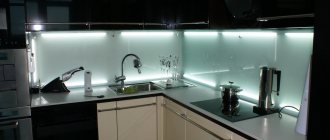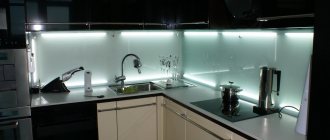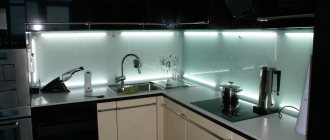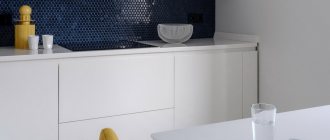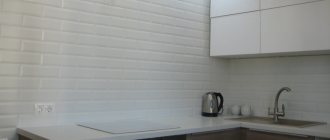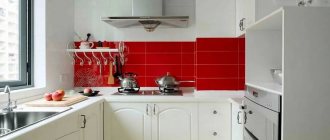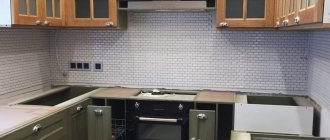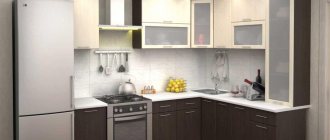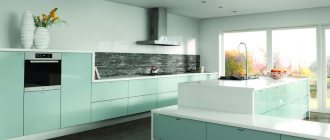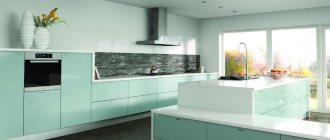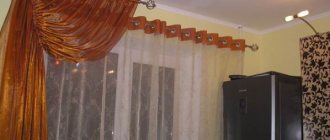The general name for glass panels for decorating walls and furniture is skin (skin - leather, lining). Skinals used to decorate the work area in the kitchen are called glass aprons. This design option appeared later than others, but immediately attracted the attention of consumers. A glass kitchen apron has become an original way to transform a kitchen, making it bright and unique.
Angular model Source m.2gis.ru
Advantages and disadvantages
Glass aprons have become a fashionable interior detail due to the following consumer qualities:
- Strength. Glass panels are resistant to damage as they are made of tempered glass.
- Wear resistance and, as a result, long service life. The glass of the apron has increased resistance to high temperatures and mechanical loads (accidental impacts).
- Easy to care for. The apron has no seams between the tiles. Dirt is removed with water and standard detergents.
- Hygiene. The smooth, non-porous glass surface is unable to absorb water and grease, and therefore does not create an environment for the development of bacteria.
- Design possibilities. A glass apron reflects light and visually enlarges the space. It is possible to choose a finish of any color; color rendering is always impeccable.
There are no seams between the tiles Source ideasonthemove.com
People make a choice in favor of a kitchen apron, being aware of its shortcomings:
- Price. A product made of high-quality tempered glass always costs more than plastic or ceramics. But plastic can be deformed from strong heat, and the seams in a ceramic apron can become a breeding ground for mold.
- Difficult to install. Sometimes delivery and installation are complicated by the design of the corner kitchen skin. This apron must be installed by a specialist.
- Limitations of care. Glass kitchen aprons should not be cleaned with abrasives. The abrasive will not damage the pattern under the surface, but will reduce the transparency of the glass.
Reliable and beautiful Source seoceros.com
Polycarbonate apron
Polycarbonate is very similar to plexiglass, but has qualities more suitable for the role of a kitchen apron.
Pros: a glass panel for a kitchen made of polycarbonate will be much cheaper than panels made of stalinite, triplex, tiles and other popular materials. More resistant to elevated temperatures than plexiglass and stronger than tempered glass. In addition, it is lightweight, flexible, and you can install it yourself.
Cons: the main drawback is that it scratches quickly and is inferior to ordinary glass in appearance.
Which glass is suitable for an apron?
The kitchen work area is subject to significant (and sometimes unexpected) loads, so for reasons of durability and safety, tempered glass (Stalinite) is preferred. It is recommended to install an apron made of heat-resistant stalinite (7-10 times stronger than ordinary glass) near the stove.
A very strong blow can break tempered glass. At the same time, it will break into small fragments with blunt edges that are not capable of causing serious problems. Understanding the importance of the question of what kind of glass a kitchen apron is made from, most companies use glass 6-8 mm thick. There are other types of glass for kitchen skins:
- Triplex. The material consists of two layers of silicate or tempered glass, bonded with a polymer film. Thanks to this layer, upon impact, the apron does not break into fragments, but becomes covered with cracks. At the request of the customer, the film is made transparent or decorative (with a pattern). In the kitchen, triplex skins are not often found due to the high cost of the material and the complexity of installation (difficulties with installing roof rails and cutouts for sockets).
Bright poppies for a good mood Source opora-stroy.ru
- Plexiglas. The name hides acrylic - a plastic that can be tinted and painted. The material is environmentally friendly, durable and lightweight (weighs 2 times less than glass), but it is prohibited to install it behind the hob. When heated above 80°, it begins to deform.
- Polycarbonate. It is distinguished by its budget cost and durability. The only drawback is that under the influence of ultraviolet radiation it becomes cloudy, turns yellow and becomes brittle. It is better to choose a brand that contains UV stabilizers.
Made from plexiglass Source innofashion.ru
When choosing a material for an apron, you need to take into account the fact that tempered glass comes in two types:
- Float glass (M1, display case). It seems absolutely transparent, but in thickness it acquires a pronounced greenish “bottle” tint. The effect does not appear on an apron with bright, saturated colors. But, if a landscape or still life is made in light colors (or on a light background), a greenish tint can negate all the beauty.
- Lightened (bleached, Optiwhite). Glass from which all iron oxides, which give a greenish tint, have been chemically removed. It acquires special transparency and is suitable for skinnals in pastel colors. The only disadvantage of the material is its price, 30% more expensive than usual.
Float glass is suitable for this range Source mekskinali.ru
See also: Catalog of companies that specialize in the development and implementation of interior redevelopment of a private house
Plexiglas apron
Plexiglas is often called acrylic glass, PMMA glass, and it is also produced under the names plexiglass, acrylite, carboglass, limacryl, etc.
Pros: plexiglass cannot be broken, it is very cheap, light, flexible, undemanding to the quality of the wall. You can install it yourself and trim it yourself, if necessary, add holes for sockets, etc. The advantages include fast production times, design variability, moisture resistance, impact resistance and environmental friendliness - even when burned, plexiglass does not emit harmful substances.
Disadvantages: it scratches, becomes dull, you cannot wash the apron with abrasives and hard sponges, it is afraid of acetone and alcohol, it can become deformed from overheating (at temperatures above 80 C°), so it is not advisable to install plexiglass behind a gas stove. It also loses to regular and tempered glass in appearance and transparency.
Types and variations of design: plexiglass can be colored (painted in the mass), as well as decorated with photo printing.
Varieties of design
The glass panel can have different designs and is made in the following ways:
- Budget option: without color or pattern. A transparent apron without a color pattern is chosen to protect a wall covered with paint or wallpaper from splashes. If you don't like the smooth glass surface, it can be sandblasted or chemically etched. The result will be satin (frosted) glass.
Transparent protection Source insideakwaibom.com
- Made from plain colored glass. The laconic monochromatic surface has a stylish look and can serve as an accent in the kitchen design. Light shades will add volume, bright shades will add a note of cheerfulness to the atmosphere, and contrasting shades will tie together interior details and accessories. It’s nice that you can choose almost any color - the palette of available shades is inexhaustible.
Single-color tinting Source c-di.kiev.ua
- Stemalite (or enamel, enameled glass). A layer of opaque ceramic paint is applied to one side of the tempered glass. The paint is burned into the glass surface and becomes an inseparable part of it. The enamel is applied to transparent or tinted glass, thereby achieving various decorative effects. The stomalite layer is reliable and durable, it is difficult to damage even with a knife.
Enameled glass Source hdinterior.ru
- With photo printing. A full-color image is applied to the back of the glass surface using a UV printer. The drawing looks bright and as realistic as possible, which is why photo printing is the leader in popularity. The panel with photo printing is durable: the UV layer does not fade, is not afraid of moisture and can withstand heating up to 120°. The panel with a 3D effect looks impressive, but such pleasure is more expensive.
Drawing made using photo printing Source 2gis.ru
- With vinyl film. A budget option for designing a work area. The design is printed on clear vinyl self-adhesive and then rolled onto the inner surface of the skin. The decorative film is protected from moisture and temperature changes, but there is a non-zero chance that over time it will begin to fade and peel off.
The film is reliably protected by glass Source dekor-td.ru
- Mirror apron. Glass for a kitchen backsplash with a mirror layer is valuable because it creates the illusion of enlarging the room. To make the work area look like a single whole, it is important to cover the entire surface with a mirror. If you do this only on part of the wall (for example, just above the sink or near the stove), the effect will disappear, the space will look “cut up”.
The best way to increase space Source el.decoratex.biz
- Illuminated with LED strip. Whatever the material and image of the apron, properly selected lighting will enhance its decorative effect. There is a second plus: the working surface will be illuminated by the main and reflected light, significantly saving electricity. The tape is attached around the perimeter of the panel, less often inside. LED RGB strips can change color, which increases their design capabilities.
With lighting Source forum.leroymerlin.pl
See also: Catalog of companies that specialize in completing unfinished houses
What about the apron under the hood?
In modern kitchens, it happens that the hood is installed above the bottom edge of the wall cabinets. In such cases, in order for the glass apron to look like a solid composition, it is necessary to cover the space under the hood with glass. There are several ways to do this. In each specific case, the InterGlass company’s craftsmen will offer a choice of at least 2 manufacturing options: solid glass or a separate piece, and will give their recommendations based on the customer’s experience and budget.
An apron under the hood is a matter to be resolved individually. There can be many pitfalls here, ranging from the size of the gaps and internal cutouts in the glass to the location of gas pipes and the overall length of the apron.
Selection principle
When choosing the color of the skin, the following features of color perception are taken into account:
- Pastel and neutral shades are a must for a small or windowless kitchen. The best solution would be a combination of a glossy finish and LED illumination of the work area.
- If the room design has enough bright, saturated colors (walls, textiles, countertops, cabinet fronts), a light apron will help balance the palette. A monochrome pattern can also serve as balance.
- You should be careful with patterns in acid colors, although in some styles (high-tech) it looks organic. A bright color diluted with white is acceptable for a modern interior, provided it is supported by details: dishes, textiles, fittings.
Contrast solution Source vachtamkinhhagia.com
Tips for choosing a glass splashback
Here are a few basic tips that will help you avoid mistakes when choosing and ordering skins.
- When making skins to order, indicate the required dimensions, and also double-check the holes for sockets, switches, and fasteners on the diagram several times. If the manufacturer offers to take your own measurements for an additional fee, it is better to take advantage of this opportunity.
- When comparing prices from manufacturers and choosing the best offer, take into account the different scope of services. Work of a measurer, creation of a layout, cost of different methods of drawing, processing of ends, delivery, installation. The low price may be worth the convenience.
- If you decide on a subject image on the apron, then first “try it on” - in a photo editor, superimpose the picture on a photo of the kitchen. Evaluate the result from all sides - won’t you get tired of it in a month? Can you use seasonal decor? Will there be too much color and detail in the kitchen? Because such skins are indeed a very active element in design.
- Order a glass apron only after installing the headset. This is not a dirty job, and there is no need for thorough cleaning afterwards. But you definitely can’t go wrong with the size and location.
Skins in different interiors: choosing a pattern
The image plays an important role in the perception of the kitchen, so it is chosen as carefully as the color scheme. Popular themes include the following:
- With macro effect. These may include birds, wild plants, fruits and vegetables. Pictures with culinary themes look excellent: coffee beans, kitchen utensils, a scattering of spices.
With macro effect Source minsk.deal.by
- With the effect of a false window. An image of a deserted beach, sea surface or a view of a night metropolis will visually enlarge the space.
With a view of the city Source stroimbistro.ucoz.ru
- Abstractions. The image of avant-garde geometric shapes, mesmerizing recursion or soothing expressionist motifs suits the role of interior accent like nothing else.
Abstract motifs Source fishki.net
The popularity of flower images lies in their unsurpassed ability to create a comfortable atmosphere. The type of colors is chosen in accordance with the style of the kitchen:
- Orchids. A universal image that is suitable for both classic and modern interiors. The pattern of luxurious colors will favorably emphasize both the refined range of modernism and the strict palette of high-tech. When choosing, preference should be given to large designs: the exquisite form of an orchid in a small design will lose half of its attractiveness.
Universal design Source glass-store.ru
- Wildflowers. Chamomiles, dandelions and cornflowers are a good choice for a rustic style. For a Provence-style kitchen, the best option would be an apron with a picture of lavender, perhaps in combination with household utensils.
In Provence style Source a-house.by
- Spring flowers. For a kitchen in the Art Nouveau (and Mediterranean) style, romantic images of daffodils, lilies of the valley or tulips are suitable.
- Stylized flowers. For strict minimalism and ascetic hi-tech, a pattern in retro style, in monochrome, blurred (with a rain effect) is suitable.
Spring freshness Source keraton.spb.ru
Images of the underwater world, cities, landscapes and still lifes are selected taking into account the color palette of the kitchen. To make the design of the skinali an accent, choose a color for it that is opposite to the color of the surrounding pieces of furniture. If you want to install a wall panel in the color of the countertop and furniture, transfer the accent to the rest of the furniture - make it a shade or two darker.
Plain wall panels are favorites of urban styles: minimalism, hi-tech, loft, techno, but they are also successfully used to decorate classic kitchens. The color of a plain kitchen apron is chosen to contrast with the countertop and furniture.
In the spirit of minimalism Source kitchenonline.ru
Types of fastening glass panels
A glass apron for the kitchen is attached either to “liquid nails,” that is, silicone, or to special fasteners that are also suitable for mirrors.
The first option is much more preferable, since it is possible to make the joints between the walls blank, and this guarantees the durability of the pattern and the chance of breaking such a panel becomes minimal.
We do not advise you to use hinged or through fasteners.
Firstly, the attachment points will be visible, and secondly, a gap will form between the wall and the panel, which will collect condensation and dirt. But most importantly, this panel is very shock-resistant. Due to the fact that it is suspended, it is much easier to break it than if it is tightly glued.
What to look for when choosing
Glass splashbacks for the kitchen are limited in size. The largest size is 3300*2140 mm. If the wall is larger, then several panels are used at once, which create a unified style.
Optiwhite is often used to create designs on glass, since it is a transparent canvas without a greenish tint, on which the design is bright and clear.
You need to look at the thickness. This value depends on the size of the aprons. For short canvases, the optimal thickness is 0.4-0.5 cm, for long ones - from 0.6 cm.
Photo of triplex panels
The pattern on the apron plays an important role when choosing. Film application involves the use of an adhesive film and its further processing in a vacuum chamber. When purchasing such aprons, you need to make sure that the design lies flat on the glass and that there are no bubbles on the film itself.
It is better to entrust measurements for aprons to craftsmen, since the manufacturing error is only 0.1 cm. A thoughtful choice of aprons serves as an indicator of a long service life. Tips for choosing a good model:
- Tempered glass is a reliable raw material, since it is not even afraid of accidental touches with a hot saucepan.
- Combination with style - a kitchen apron should emphasize the interior, creating a unified picture.
- When installing above a stove, you need to choose only heat-resistant materials.
- When the kitchen is located on the south side, inexpensive materials for aprons, such as polycarbonate, quickly fade and turn yellow.
- It is better to entrust the installation of aprons to trained people if you lack confidence in your abilities.
Canvas with photo printing
The main condition for the finished canvas is that it matches the shape and size of the surface on which it will be installed. Craftsmen do not recommend installing canvases longer than 2.5 meters, but it is better to use several panels.
